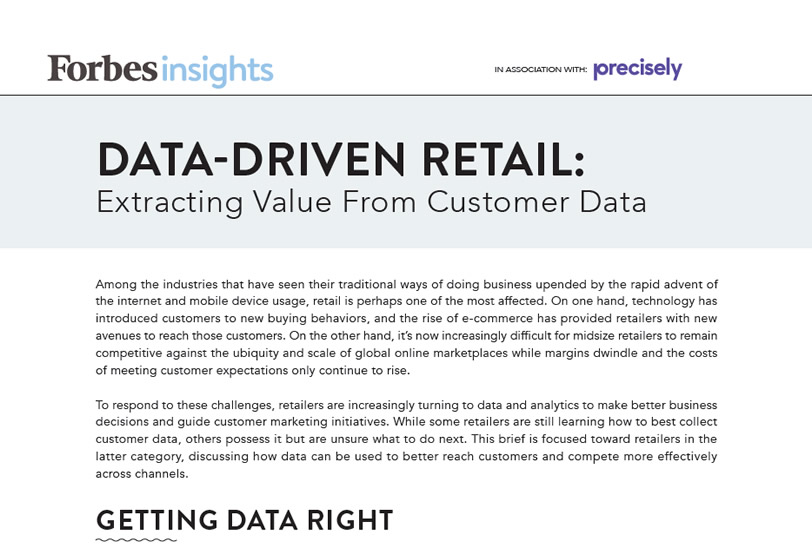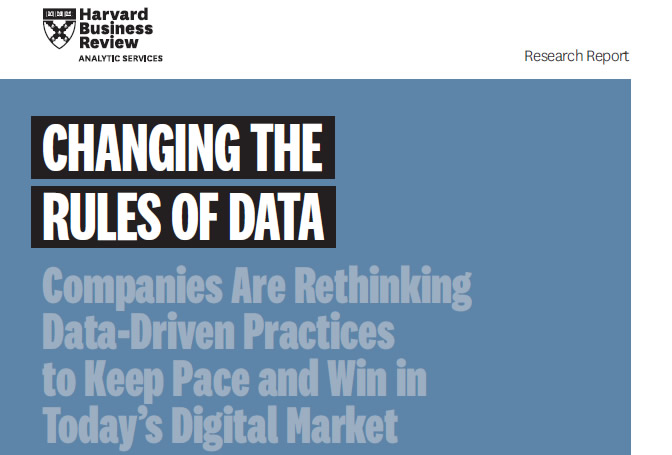Data-driven solutions for retail
Develop consumer context, optimize channel selection, and create meaningful marketing interactions with accurate data and analytics for retail

Data-driven retail
Retailers are challenged with creating more personalized, customer-centric experiences to better reach customers and compete more effectively. To respond to these challenges, they are turning to data and analytics to make better business decisions and guide customer-marketing initiatives.
Data-driven retail requires blending external data sources, such as demographics and points of interest, with internally held customer data, like transaction histories and loyalty status. When combined, this data helps to establish a trusted single-view of a customer.
Once the right blend of data has been determined, location analytics tools then provide retailers with the resources required to analyze the data and develop a successful retail strategy. Spatial analytics can be used to identify new sites, evaluate the competitive landscape, and drive additional revenue and margin.
Retailers who leverage location and consumer data with spatial analytics outperform the competition, attract and retain customers, and optimize operations with the actionable insights gleaned.
Complex site selection and network planning
Success in retail means outpacing the competition. With consumer expectations constantly rising, that’s no easy task.
Site selection is one of the most important decisions a retailer can make. The right location will drive growth; the wrong one will drain resources. You need location intelligence to measure performance potential, assess the impact of cannibalization, and act quickly on the best emerging opportunities.
But growth is rarely about a single site. The real advantage comes from optimizing your entire network. Precisely’s store network planning solution, Spectrum Spatial Insights, combines your data with our curated datasets, predictive models, and consulting expertise. Delivered as a managed service, it enables you to model scenarios, forecast performance, and target the most profitable opportunities across every location.
Our solutions were built to accelerate your decision-making. Delivered in a collaborative platform, we make it easy to assemble and share all the relevant information required for site investment decisions. Our powerful opportunity scans provide your teams with a roadmap for growth, highlighting the best opportunities for investigation.
With frequently updated datasets, competitive intelligence tools, and expert consulting, Precisely helps retailers stay ahead of the competition with data-driven confidence.


Domino’s Pizza leveraged Precisely’s location intelligence tools and data for site selection
“We are confident the changes we have implemented will not only help improve productivity but will also deliver an increase in revenue for both Domino’s and our franchisees”
– Wayne McMahon
Chief Information Officer, Domino’s
Build location-based customer profiles
A customer profile is not complete without location. From the type of neighborhood someone lives in, to the average age of a census block, location provides enriching context for creating market segments.
Customer records appended with location attribution can produce greater insights into targeting, acquisition, and retention and improve profitability. For example, seeing that a customer’s purchase history has slowed may initially suggest they are losing interest in the brand. Analysis with Precisely’s street datasets and location intelligence software may show that the highway connecting your store and the customer’s home recently closed, making it less convenient for them to shop at your location. Now, you can respond with a personalized offer for free delivery, or a coupon for another location more accessible to them.
Hyper-personalization is made possible through accurate, in-depth customer profiles. Demographic information, from the macro to micro level, is key to generating strong profiles and customized retail experiences. Precisely’s demographic data is available at multiple scales to give you flexibility in the scope of your analysis. Whether analyzing an entire county or an individual, Precisely Demographics provides the detailed attribution needed to meet customer expectations.
Precisely’s geocoding and geospatial analytics tools enable you to see how these populations relate to a location and ultimately impact retail performance. Store catchment areas created with location intelligence tools identify nearby geographies, and demographic data reveals who lives there, so you can target them effectively. This insight into people, their lifestyles and geographic proximity to your store informs marketing campaigns crafted to meet rising consumer expectations.
Learn how a digital graphics innovator uses Precisely’s location data to gain a picture-perfect customer view.


Deploy geofences and beacons for location-based marketing
Geofences around commercial locations enable push and text notifications to be sent to prospective customers’ mobile devices. Retailers can use their own locations, as well as those of complementary businesses or competitors, to trigger ads on devices entering and exiting the defined boundaries. Opening near a complementary business or competitor may boost the amount of traffic a site receives and increase market share.
Precisely Places supplies both pre-defined geofences around popular commercial locations as well as accurate points on which to base the creation of new boundaries. Our location intelligence tools enable you to define customized geofences around accurately geocoded points for effective mobile marketing campaigns.
Beacons sent from commercial locations to mobile devices in a surrounding radius can be similarly leveraged. Messages sent to nearby devices can attract customers by providing estimated drivetimes to the store and special mobile offers. Precisely provides the detailed attribution needed for informed beaconing pre-built into our datasets, and our software allows you to further analyze a location and customize for specific needs.
Data-driven geofencing and beaconing increase the effectiveness of marketing impressions, helping retailers reach their target audience in a meaningful way. Strategically placed notifications also improve in-store conversion rates and drive foot traffic. These geospatial marketing tools empower retailers to meet customer expectations for personalized messages and offers, while increasing profitability.
Location analytics powers geofencing and beaconing. Retailers can craft messaging and offers to consumer preferences, reaching customers the right way at the right time. But as with any customer interaction, accuracy matters. Geofences and beacons created using Precisely’s best-in-class geocoding and specially curated datasets ensure you reach your intended audience.
Read how Precisely enables more effective content, offers, and messaging.

To optimize those master data processes and create stronger customer relationships, Groupe L’Occitane needed solutions that would help their team work more efficiently and boost personalization for their loyal customers.
“Its ease of use means we can create and update scripts without involving IT, reducing the strain on IT resources”
– Grégory Russo
SAP Solution Manager, Groupe L’Occitane

Stay on top of taxes
Every business, from large organizations to individual business owners, needs to be aware of their tax obligations. However, tax boundaries and rates are constantly changing. Precisely’s Spectrum Enterprise Tax solutions provide accurate tax assignments instantly. Have confidence in the assignment of state, county, township, municipal, and other local tax information associated to an address.
Many organizations today are integrating Precisely’s GeoTAX solution into their business processes, ensuring that whether they are purchasing a new vehicle or mobile plan, they are confident in all tax assignments. Even small business owners can access this cost-effective resource through our Software-as-a-Service (SaaS) GeoTAX solution for a single customer or many.
Experience for yourself how easy and cost-effective it can be to integrate accurate tax assignment into your business.





